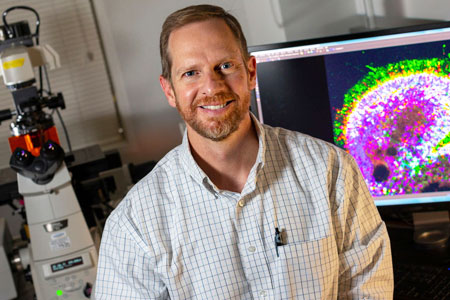| Meet the University of Wisconsin-Madison’s David Gamm Professor of Ophthalmology & Visual Sciences |
 |
Research area Degenerative eye diseases that culminate in the death of photoreceptors and retinal pigment epithelium (RPE) are a leading cause of untreatable blindness in the United States and the world. The Gamm Laboratory employs pluripotent stem cells to investigate how the human retina develops, and then uses this information to design and test gene and cell therapies aimed at treating numerous retinal disorders. Particular diseases that the research group is working on include retinitis pigmentosa, age-related macular degeneration, Usher syndrome, Stargardt disease, Choroideremia and Best disease.
What excites you about your work?
“As a physician-scientist, it’s a unique privilege to go into my laboratory and work on problems that I see in the clinic but can’t treat due to a lack of available therapies. The ability to take on any challenge, fill knowledge gaps, and explore new treatment strategies for children and adults with devastating blinding disorders—and not just wait for someone else to do it—is incredibly motivating. And by no means do I work alone in these endeavors—I get to work with an incredible team of brilliant and compassionate scientists. Together, my team takes human stem cells, which have the theoretical capacity to generate any cell or tissue in the body, and coerces them to become authentic human retinal tissues and cells, including photoreceptors (which are arguably the most complex cells in the body). In about 250 days, we can grow a functioning human mini-retina in a dish—it’s been 15 years since we discovered how to do it, and it still amazes me.”
What do you hope to achieve?
“I want to understand how retinas are made and why different diseases cause them to fail and degenerate. Ultimately, our aim is to apply that knowledge to manufacture more authentic human retinal cell types and tissues that can be used to advance therapies for people at every stage of disease. We do so in part by creating “retinal disease in a dish” model systems to test gene and genome therapies that have the ability to prevent blindness before it happens, or to slow or halt the blinding process once it has gained a foothold. In addition, these lab-grown cells may be able to replace dead photoreceptors and RPE in older individuals who have already experienced profound vision loss. Our efforts have attracted the interest of wonderful industry partners who have helped us establish and grow a company that is close to initiating first-of-their-kind clinical trials to treat retinal degenerative diseases. We know that these are very difficult problems with no easy solutions, but we are thrilled to play a major role in moving the field forward and—hopefully soon—helping people who have nowhere else to turn.”
David’s work involves utilizing human pluripotent cells to investigate retinal development and potential treatment for people with degenerative eye diseases. He is a recognized world leader and his innovations are finding their way into human clinical trials. We are grateful for Dr. Gamm’s partnership and excited to play a role in advancing his discoveries.
– Andy DeTienne, WARF, Director of Licensing
Want to learn more?
Andy DeTienne, [email protected], 608.960.9857